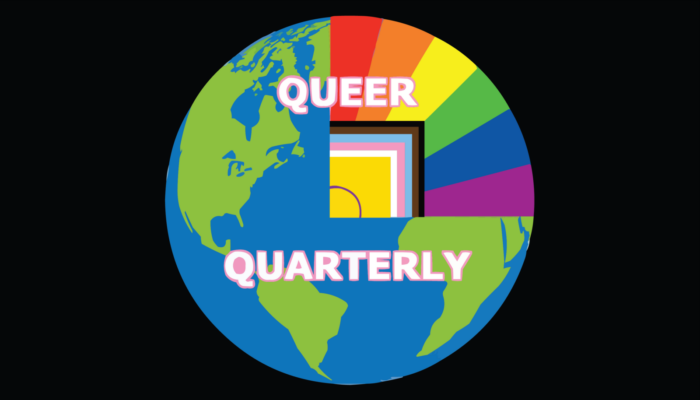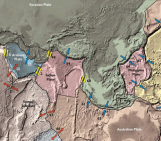
Queer Quarterly is the blog series of the EGU pride group, a LGBTQIA+ team of geoscientists engaged to uphold and improve the rights of the community in the EGU organization. This week’s post is dedicated to allyship: how people outside of the community can support our efforts.
The term LGBTQIA+ is the abbreviation for Lesbian, Gay, Bisexual, Transgender, Queer, Intersex, and Asexual. The additional “+” stands for all of the other identities not encompassed in the short acronym. An umbrella term that is often used to refer to the community as a whole (Glossary of the LGBTQIA+ Resource Center of UC Davis, California).
What does queer visibility mean in academia?
As a queer early career scientist, I always found discussions about visibility interesting. Most of the time, the mention of visibility stopped at the point where visibility is either suggested or requested from queer scientists, while several other aspects of visibility are not explored. What does visibility even mean in terms of queerness? Visibility is often assumed to drive inclusion and diversity, but as stated in the report “Exploring the workplace for LGBT+ physical scientists” – “Unlike many other aspects of diversity, LGBT+ identity is often hidden, and not necessarily obvious to others in the workplace”. So, what does it mean to be visible in practice? How do queer scientists feel about their own visibility? And where can I start to increase my own visibility if I feel like it? With these questions in mind, I interviewed three different scientists in academia, who I would argue make themselves visible in academia.
Mike Prior-Jones stated very early on in the interview that for him visibility needs to be pushed out as a decision, because otherwise it is easy to be placed into the role of a straight man. So after coming out in Antarctica, being out at the workplace in industry and academia was the default.
When Dani Jones talked about their public coming out during the pandemic, their reasoning seemed to always circle around wanting to express themselves in an honest way. With the result being that it just felt more worry-free to be honest.
Having worked in the US and South America before starting their doctoral studies in Finland, Margo Williamson’s approach to visibility seemed to be additionally guided by queer context clues and a focus on community finding each other. But also highlighting how some parts contributing to her visibility feel non-negotiable as they are so intertwined with oneself.
The very literal approach to visibility seems to be flags and stickers: Immediately at the start of the call I noticed two small trans and non-binary flags in Dani’s office background. Along the same line, Mike adds the Pride in Polar Research sticker to all his presentations in the group of affiliations sections, which seems to be a very practical approach. My EGU Pride sticker, acquired at the EGU general assembly in Vienna, also lives its open life on my water bottle. However, we should probably not treat pride stickers and lanyards as a definitive marker for a queer person, as they are often also handed out to allies to show their support. Furthermore, in some cases, such as pronoun pins, we should encourage all people to wear them at public events and conferences specifically to prevent a pronoun pin being a mark of queer visibility.
Another “queer visibility classic” seems to be talking openly about your relationship at work. This seems to be a very natural approach in safe environments. While living in countries where it was unsafe to be openly gay, Margo used phrases like “No, I don’t date boys.” or like “No, I am an independent lady.” to answer questions about partners without playing along the heterosexual norm as it felt truer to herself, but also a nod to other potentially queer people in the vicinity. Talking openly about one’s relationship as an approach to visibility obviously excludes cases such as single queer people, some of those on the asexual and aromantic spectrum who may have no desire for a partner, and bisexual and or transgender people, who are in a relationship others do not read as queer. Additionally, this approach seems to break down with trans visibility. Personally, I struggle to find a nonchalant approach to mention my own transness in a coffee conversation at the office, even though I might have arrived late on that day from a nurse appointment regarding my regular blood work.
In all interviews it was obvious that actively being visible is a part of community building. While initially being reluctant to include the Pride in Polar Research sticker into outreach presentations he gave at schools, Mike experienced appreciation from teachers once he started. Similarly, both Dani and Mike got applications from other queer people because they felt more comfortable to apply to another queer person.
While still being in the US, it felt more necessary for Margo to make clear throughout the hiring process that she is lesbian as part of conversations compared to Europe as there were periods of time when she could legally be fired for being gay in the US. Thus, ensuring that she would be working in a more acceptive environment. Additionally, being visible upfront in more male-dominated areas or on fieldwork created a form of “safety” from potential homophobic “jokes” used as bonding as well as created a clear “no” to any sexual or romantic interest shown by male colleagues.
Most of the above discussions of visibility are voluntary, even though it feels very necessary to the individual to share their queerness. Nevertheless, it seems important to also highlight that some parts of queerness cannot always be hidden. As academic circles seem to be somewhat small communities in the end, trans people, who start their transition by changing names or pronouns while already being in academia, will potentially always have colleagues who could remember their past selves. While all EGU journals should employ an inclusive name-change policy, this is not available with all scientific journals.
Another aspect of potentially involuntary visibility occurred to me while talking to Dani about pronouns. In most cultures, pronouns are gendered and usage of gender-neutral pronouns, like they/them pronouns, require active announcing (e.g., in email signatures or on your presentation slides).
In every interview we at some point discussed, that being visible at the end is very similar to coming out in the fact that it is not really a one-time situation. Rather, it is a continuous process, especially at new workplaces, with new collaborative partners or a new batch of students. To me, understanding this properly also highlighted why I feel sometimes awkward about visibility. It is not that I mind people knowing about my queerness, but rather that it feels like a normal part of myself and making it actively visible feels sometimes clunky, because it is a muscle I have not trained that well yet.
If visibility drives inclusion of queer people in academia, what is then the responsibility of a minority in this? Dani, Margo and Mike all agreed with each other that mostly being visible at the workplace was the best choice for their own well-being and being authentically themselves. Being visible for other colleagues or students was always the second mentioned motivation. This order of motivation feels important as one should know their own boundaries as Margo said, being visible and queer feels important for her own happiness and wellbeing but not everyone feels that way and you have to know where your boundaries are. Which also highlights that, of course, making academia a welcoming place for queer academics (or other minorities) cannot be the sole responsibility of queer academics and cannot solely be achieved by visibility, but rather by fostering safe environments due to culture, and also by protecting minorities with policies and legal frameworks.
Making our workplaces, and academia as a whole, a safe and welcoming environment for people belonging to any minority should always be in all of our interests. To supplement some further reading, please also read, for example, this recent blog post on GeoLog with a multitude of additional information. If any non-queer readers are looking for practical advice of actions, which could be implemented on different organizational levels, please check, for example, the above-mentioned report on workplace experiences of queer scientists, this recent systematic literature review on the learning and working environments of queer individuals in STEM or this publication about making your sea-going research more trans inclusive.
Information on the interviewees and author
Author of this post:
Marek Muchow (he/him, they/them) is a doctoral researcher in sea-ice modelling and ice mechanics at Aalto University (Finland) with a background in oceanography and climate physics. Additionally, he is also very interested and involved in community building within academia and is an active member of EGU Pride.
Interviewees:
Mike Prior-Jones (he/him) is a glaciologist with a background in electronic engineering, and is currently a research fellow at Cardiff University in the UK. He leads a group that develops wireless instruments for studying glacier hydrology. He first worked in Antarctica as an engineer in 2005 and spent the winter on a research station. He later had a private sector career and returned to academia as a glaciologist in 2019.
Dani Jones (they/them) is an environmental data scientist with a foundation in physical oceanography, applied mathematics, and numerical modeling. They lead projects at the intersection of machine learning, data analysis, and modeling to address environmental challenges. Currently, they are establishing the Great Lakes Artificial Intelligence Laboratory, focusing on innovations like observing system design and water level forecasting.
Margo Williamson (she/her) completed her Bachelor’s work in coastal wetland ecology and her Master’s in coastal groundwater hydrology. She worked for 15+ years as a field biologist and ecologist for various government and private institutions before moving to Finland to work as a Doctoral Researcher in coastal ecology.
EGU Pride has a Short course at EGU
SC 1.3 The LGBT Pride group at EGU: Current progress and challenges for LGBT people in the Earth system sciences, and ideas for how to overcome them
Tuesday, 29.04 16:15 – 18:00


